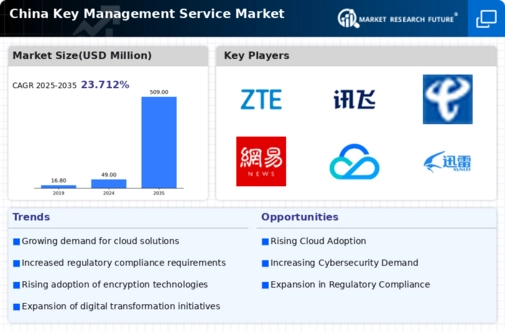Emergence of IoT Devices
The proliferation of Internet of Things (IoT) devices in China is significantly impacting the key management-service market. As more devices become interconnected, the volume of data generated increases, necessitating robust key management solutions to protect sensitive information. In 2025, it is estimated that the number of IoT devices in China will exceed 1 billion, creating a vast landscape for potential security vulnerabilities. Organizations are recognizing the importance of implementing key management services to secure communications and data exchanges between IoT devices. This growing awareness is likely to drive investments in key management solutions, as businesses seek to mitigate risks associated with IoT deployments and ensure the integrity of their data.
Rising Cybersecurity Threats
The increasing frequency and sophistication of cyberattacks in China is a primary driver for the key management-service market. Organizations are compelled to adopt robust key management solutions to safeguard sensitive data and maintain compliance with stringent regulations. In 2025, it is estimated that cybersecurity spending in China will reach approximately $30 billion, reflecting a growth of around 15% from previous years. This surge in investment indicates a heightened awareness of security vulnerabilities, prompting businesses to prioritize key management services as a critical component of their cybersecurity strategy. As threats evolve, the demand for advanced key management solutions that can adapt to new challenges is likely to grow, further propelling the market forward.
Digital Transformation Initiatives
China's ongoing digital transformation across various sectors is significantly influencing the key management-service market. As organizations transition to cloud-based infrastructures and adopt digital tools, the need for effective key management becomes paramount. In 2025, the digital economy in China is projected to account for over 40% of the country's GDP, underscoring the urgency for secure data management practices. Companies are increasingly recognizing that without proper key management, the benefits of digital transformation could be undermined by security risks. Consequently, investments in key management services are expected to rise, as businesses seek to ensure the integrity and confidentiality of their digital assets.
Increased Adoption of Cloud Services
The rapid adoption of cloud services in China is a crucial driver for the key management-service market. As businesses migrate to cloud environments, the need for secure key management becomes increasingly critical. In 2025, it is projected that cloud computing will represent over 30% of the total IT spending in China, highlighting the shift towards cloud-based solutions. This transition necessitates the implementation of effective key management strategies to protect data stored in the cloud. Organizations are likely to invest in key management services that offer seamless integration with cloud platforms, ensuring that their data remains secure and accessible. The growth of the cloud services market is expected to directly correlate with the expansion of key management services.
Growing Demand for Compliance Solutions
The evolving regulatory landscape in China is driving the demand for key management services. Organizations are facing mounting pressure to comply with data protection laws and industry standards, which necessitate the implementation of effective key management practices. In 2025, it is anticipated that compliance-related expenditures will constitute a significant portion of IT budgets, with many companies allocating upwards of 20% of their IT spending to compliance solutions. This trend indicates a strong market for key management services, as businesses strive to avoid penalties and reputational damage associated with non-compliance. The key management-service market is likely to benefit from this focus on regulatory adherence, as organizations seek reliable solutions to manage encryption keys and sensitive data.

























Leave a Comment